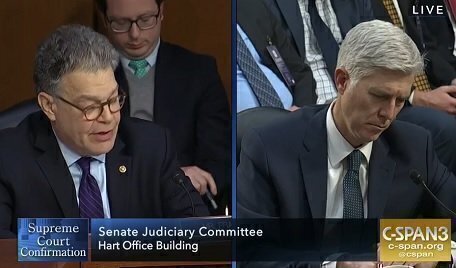On the same day Neil Gorsuch started to end his Senate testimony, the Supreme Court issued a unanimous decision that overruled a case based in part on a 2008 ruling made by Gorsuch.
 In the case of Endrew F. v. Douglas County School District, Chief Justice John Roberts spoke for a unanimous court in a case about an autistic Colorado boy whose parents put him in a special school after they became dissatisfied with plans worked out for him by public school officials outside Denver.
In the case of Endrew F. v. Douglas County School District, Chief Justice John Roberts spoke for a unanimous court in a case about an autistic Colorado boy whose parents put him in a special school after they became dissatisfied with plans worked out for him by public school officials outside Denver.
The Tenth Circuit Court had ruled in favor of the local school district, applying several precedents of that Circuit Court following a “bare minimum” approach. One of the precedents on which the three-judge Circuit panel relied was a 2008 opinion written by Circuit Judge Neil Gorsuch, who was not part of the later three-judge panel.
Chief Justice Roberts said that students with disabilities have a legal right to educational support at school that will enable each one to make measurable progress, and it is not enough that progress is simply more than a bare minimum.
When asked about the Supreme Court decision by Democratic Senators Richard Durbin and Amy Klobuchar, Gorsuch defended his lower-court ruling nearly a decade ago. “If anyone is suggesting that I like a result where an Autistic child has to lose, that's a heartbreaking accusation to me. But the fact of the matter is that I was bound by circuit precedent," he said.
Gorsuch also told Klobuchar it would be mistaken to conclude his opinion was out of the mainstream, since other federal courts had reached similar conclusions.
In other notable exchanges, Senate Judiciary committee chair Chuck Grassley tried to get Gorsuch to commit to considering video cameras at the Supreme Court, an idea that Grassley has publicly endorsed. Gorsuch said he would keep an open mind about the concept.
Dianne Feinstein also tried to get Gorsuch to comment on his originalist views of constitutional interpretation and how they would impact issues such as abortion rights. Gorsuch insisted he had no intention of going back to “horse and buggy” days.
As Gorsuch’s testimony headed into early Wednesday evening, the Judiciary Committee was expected to meet in executive session to discuss a background check for the nominee, and then offer Senators a third chance to ask Gorsuch brief questions.
The hearing will continue on Thursday. Experts witnesses are scheduled to testify about Gorsuch. In recent nominations, Court candidates have testified directly for two days, but Samuel Alito did testify for the third day during his nomination process. The Senate Judiciary committee is expected to end the hearing on Thursday, and Grassley has said he wants a committee vote by early April.







